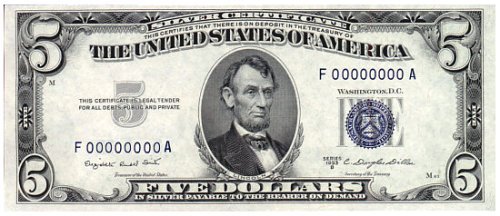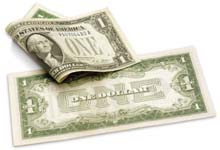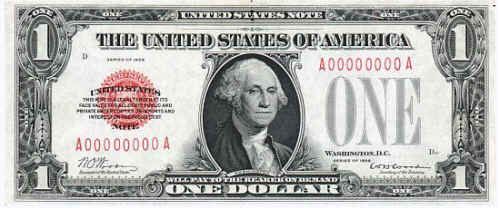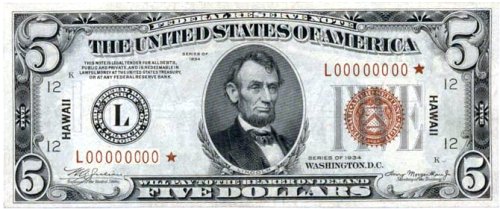Small Cents
Nickels
- Liberty ("V") Nickels
- Buffalo Nickels
- Jefferson Nickels
- Westward Journey Nickels
- Return to Monticello Nickels
Dimes
Quarter Dollars
- Barber Quarters
- Standing Liberty Quarters
- Silver Washington Quarters
- Washington Quarters
- Statehood Quarters
- U.S. Territories & D.C.
- National Park Quarters
Half Dollars
Silver Dollars
Clad Dollars
Sets
Special Issues
- Commemorative Coins
- Odd Type (Obsolete) Coins
- U.S. Type Coin Sets
- Americana Collector Sets
- Birth Year Sets
Other
U.S. Coins
United States Small Size Paper Money
Silver Certificates

In accordance with an Act of Congress, dated February 28, 1878, the Department of the Treasury issued to the public Silver Certificates which could be exchanged for silver dollars. On March 25, 1964, the Secretary of the Treasury announced that Silver Certificates would no longer be redeemable for silver dollars. Subsequently, another act of Congress dated June 24, 1967, provided that Silver Certificates could be exchanged for silver bullion for a period of one year, until June 24,1968. Even though silver certificates are no longer printed, those which remain outstanding are still legal tender and can be spent.
"Funny Back" Silver Certificates

These seldom seen $1.00 Silver Certificates acquired the nickname "Funny Backs" from their unique back design. Dramatically different from the back of any other currency, Funny Backs were printed in only two years - Series 1928 and Series 1934.
United States Notes

United States Notes (characterized by a red seal and serial number), originally issued in 1862, were the first National currency. Federal Reserve Notes were not issued until the creation of the Federal Reserve System in 1913. Both types of notes were redeemable in gold until 1933, when the United States abandoned the gold standard. Since then, both currencies have served essentially the same purpose, and have had the same value. Because United States Notes serve no function that is not already adequately served by Federal Reserve Notes, their issuance was discontinued, and none have been placed into circulation since January 21, 1971.
$2 1976 Currency
The $2 denomination enjoys a rich tradition in American history. It first originated on June 25, 1776, when the Continental Congress authorized issuance of $2 denominations in "bills of credit for the defense of America." Under this authority, 49,000 bills of the $2 denomination were issued.
In 1928, the present size U.S. Note with the portrait of Thomas Jefferson, third U.S. President and author of the Declaration of Independence, was issued.
The Series 1963A note bore Jefferson on its face and Monticello on the reverse. The Series 1976 note features a portrait of Thomas Jefferson painted in the early 1800's by Gilbert Stuart and the back design is a vignette based on an engraved reduction of the painting, "The Signing of the Declaration of Independence," by John Trumbull. The Series 1976 note was printed to celebrate the U.S. Bicentennial.
On September 12, 1996, Treasury Secretary Robert Rubin was presented with a new series $2 bill. The 1995 series notes were printed at the Bureau of Engraving and Printing's Western Currency Facility and bear the seal of the Federal Reserve Bank of Atlanta. These notes carry the signatures of Secretary of the Treasury Robert Rubin and U.S. Treasurer Mary Ellen Withrow.
590,720,000 Series 1976 $2 notes were printed. As of February 28, 1999, $1,166,091,458 in $2 notes were in circulation world-wide.
We also offer uncut sheets of $2.00 bills.
Hawaiian (Brown Seal) Currency

Notes bearing a "Hawaii" overprint were used during World War II(July of 1942) to insure identification should they have fallen into enemy hands. Types of these notes (with brown seals and serial numbers) included $1 Silver Certificates and $5, $10, and $20 Federal Reserve Notes. It was not until October 21, 1944 that all currency restrictions were revoked and normal monetary conditions returned to that area.
North African (Yellow Seal) Currency

During WWII, the U.S. had troops all over the world. Since the local economies were in ruins and a soldier might be in England one day and North Africa the next, the only way to pay a soldier would be in U.S. dollars. The problem was that large sums of cash could be captured by the enemy and used to supply their troops. The solution in the North African theater was to issue $1, $5 and $10 Silver Certificates with a yellow seal instead of the familiar blue seal. As with the HAWAII notes, they would be distinctive enough to easily demonetized if required.
Where did the dollar sign originate?
Irish immigrant Oliver Pollock moved to New Orleans, then part of the Spanish Empire, where he became a wealthy plantation owner and trader. He did most of his business in Spanish pesos, which he abbreviated with an elaborately scripted intertwined "p" and an "s."
During the American Revolution, Pollock bought supplies for the army, sending billing records to Robert Morris, a member of the Continental Congress and the primary financier of the American Revolution. Morris kept using Pollock's "p" and "s" abbreviation, which evolved into the dollar sign used today.
The word "dollar" came from one of the most common currencies in circulation in the colonies, the Spanish milled dollar, also called "a piece of eight." In 1767 Maryland began issuing paper money in one dollar denominations. In 1775 the Continental Congress began issuing paper money called a dollar as well. The term dollar was continued after the war.
Last Revised: August 26, 2012
